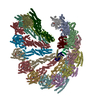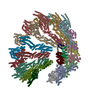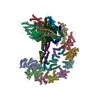[English] 日本語
 Yorodumi
Yorodumi- EMDB-52720: Human gamma-tubulin ring complex from purified centrosomes of CDK... -
+ Open data
Open data
- Basic information
Basic information
| Entry |  | |||||||||||||||
|---|---|---|---|---|---|---|---|---|---|---|---|---|---|---|---|---|
| Title | Human gamma-tubulin ring complex from purified centrosomes of CDK5RAP2-knockout cells | |||||||||||||||
 Map data Map data | Subtomogram average of human gamma-TuRC purified from CDK5RAP2 knockout centrosomes | |||||||||||||||
 Sample Sample |
| |||||||||||||||
 Keywords Keywords | centrosome / cytoskeleton / microtubule / microtubule nucleation / complex / template / cap / gamma-tubulin / gamma-tubulin ring complex / cell cycle / nedd1 / neural precursor cell-expressed developmentally down-regulated 1 / CDK5RAP2 / cyclin-dependent kinase 5 regulatory subunit associated protein 2 | |||||||||||||||
| Biological species |  Homo sapiens (human) Homo sapiens (human) | |||||||||||||||
| Method | subtomogram averaging / cryo EM / Resolution: 31.0 Å | |||||||||||||||
 Authors Authors | Hofer FW / Pfeffer S | |||||||||||||||
| Funding support |  Germany, 4 items Germany, 4 items
| |||||||||||||||
 Citation Citation |  Journal: Nat Commun / Year: 2025 Journal: Nat Commun / Year: 2025Title: Structural mechanisms for centrosomal recruitment and organization of the microtubule nucleator γ-TuRC. Authors: Qi Gao / Florian W Hofer / Sebastian Filbeck / Bram J A Vermeulen / Martin Würtz / Annett Neuner / Charlotte Kaplan / Maja Zezlina / Cornelia Sala / Hyesu Shin / Oliver J Gruss / Elmar ...Authors: Qi Gao / Florian W Hofer / Sebastian Filbeck / Bram J A Vermeulen / Martin Würtz / Annett Neuner / Charlotte Kaplan / Maja Zezlina / Cornelia Sala / Hyesu Shin / Oliver J Gruss / Elmar Schiebel / Stefan Pfeffer /  Abstract: The γ-tubulin ring complex (γ-TuRC) acts as a structural template for microtubule formation at centrosomes, associating with two main compartments: the pericentriolar material and the centriole ...The γ-tubulin ring complex (γ-TuRC) acts as a structural template for microtubule formation at centrosomes, associating with two main compartments: the pericentriolar material and the centriole lumen. In the pericentriolar material, the γ-TuRC is involved in microtubule organization, while the function of the centriole lumenal pool remains unclear. The conformational landscape of the γ-TuRC, which is crucial for its activity, and its centrosomal anchoring mechanisms, which determine γ-TuRC activity and turnover, are not understood. Using cryo-electron tomography, we analyze γ-TuRCs in human cells and purified centrosomes. Pericentriolar γ-TuRCs simultaneously associate with the essential adapter NEDD1 and the microcephaly protein CDK5RAP2. NEDD1 forms a tetrameric structure at the γ-TuRC base through interactions with four GCP3/MZT1 modules and GCP5/6-specific extensions, while multiple copies of CDK5RAP2 engage the γ-TuRC in two distinct binding patterns to promote γ-TuRC closure and activation. In the centriole lumen, the microtubule branching factor Augmin tethers a condensed cluster of γ-TuRCs to the centriole wall with defined directional orientation. Centriole-lumenal γ-TuRC-Augmin is protected from degradation during interphase and released in mitosis to aid chromosome alignment. This study provides a unique view on γ-TuRC structure and molecular organization at centrosomes and identifies an important cellular function of centriole-lumenal γ-TuRCs. | |||||||||||||||
| History |
|
- Structure visualization
Structure visualization
| Supplemental images |
|---|
- Downloads & links
Downloads & links
-EMDB archive
| Map data |  emd_52720.map.gz emd_52720.map.gz | 7.4 MB |  EMDB map data format EMDB map data format | |
|---|---|---|---|---|
| Header (meta data) |  emd-52720-v30.xml emd-52720-v30.xml emd-52720.xml emd-52720.xml | 15.5 KB 15.5 KB | Display Display |  EMDB header EMDB header |
| Images |  emd_52720.png emd_52720.png | 18.1 KB | ||
| Filedesc metadata |  emd-52720.cif.gz emd-52720.cif.gz | 4.3 KB | ||
| Others |  emd_52720_half_map_1.map.gz emd_52720_half_map_1.map.gz emd_52720_half_map_2.map.gz emd_52720_half_map_2.map.gz | 6 MB 6 MB | ||
| Archive directory |  http://ftp.pdbj.org/pub/emdb/structures/EMD-52720 http://ftp.pdbj.org/pub/emdb/structures/EMD-52720 ftp://ftp.pdbj.org/pub/emdb/structures/EMD-52720 ftp://ftp.pdbj.org/pub/emdb/structures/EMD-52720 | HTTPS FTP |
-Validation report
| Summary document |  emd_52720_validation.pdf.gz emd_52720_validation.pdf.gz | 771.7 KB | Display |  EMDB validaton report EMDB validaton report |
|---|---|---|---|---|
| Full document |  emd_52720_full_validation.pdf.gz emd_52720_full_validation.pdf.gz | 771.3 KB | Display | |
| Data in XML |  emd_52720_validation.xml.gz emd_52720_validation.xml.gz | 8.9 KB | Display | |
| Data in CIF |  emd_52720_validation.cif.gz emd_52720_validation.cif.gz | 10.4 KB | Display | |
| Arichive directory |  https://ftp.pdbj.org/pub/emdb/validation_reports/EMD-52720 https://ftp.pdbj.org/pub/emdb/validation_reports/EMD-52720 ftp://ftp.pdbj.org/pub/emdb/validation_reports/EMD-52720 ftp://ftp.pdbj.org/pub/emdb/validation_reports/EMD-52720 | HTTPS FTP |
-Related structure data
- Links
Links
| EMDB pages |  EMDB (EBI/PDBe) / EMDB (EBI/PDBe) /  EMDataResource EMDataResource |
|---|
- Map
Map
| File |  Download / File: emd_52720.map.gz / Format: CCP4 / Size: 8 MB / Type: IMAGE STORED AS FLOATING POINT NUMBER (4 BYTES) Download / File: emd_52720.map.gz / Format: CCP4 / Size: 8 MB / Type: IMAGE STORED AS FLOATING POINT NUMBER (4 BYTES) | ||||||||||||||||||||||||||||||||||||
|---|---|---|---|---|---|---|---|---|---|---|---|---|---|---|---|---|---|---|---|---|---|---|---|---|---|---|---|---|---|---|---|---|---|---|---|---|---|
| Annotation | Subtomogram average of human gamma-TuRC purified from CDK5RAP2 knockout centrosomes | ||||||||||||||||||||||||||||||||||||
| Projections & slices | Image control
Images are generated by Spider. | ||||||||||||||||||||||||||||||||||||
| Voxel size | X=Y=Z: 5.08 Å | ||||||||||||||||||||||||||||||||||||
| Density |
| ||||||||||||||||||||||||||||||||||||
| Symmetry | Space group: 1 | ||||||||||||||||||||||||||||||||||||
| Details | EMDB XML:
|
-Supplemental data
-Half map: Half map for subtomogram average of human gamma-TuRC...
| File | emd_52720_half_map_1.map | ||||||||||||
|---|---|---|---|---|---|---|---|---|---|---|---|---|---|
| Annotation | Half map for subtomogram average of human gamma-TuRC purified from CDK5RAP2 knockout centrosomes | ||||||||||||
| Projections & Slices |
| ||||||||||||
| Density Histograms |
-Half map: Half map for subtomogram average of human gamma-TuRC...
| File | emd_52720_half_map_2.map | ||||||||||||
|---|---|---|---|---|---|---|---|---|---|---|---|---|---|
| Annotation | Half map for subtomogram average of human gamma-TuRC purified from CDK5RAP2 knockout centrosomes | ||||||||||||
| Projections & Slices |
| ||||||||||||
| Density Histograms |
- Sample components
Sample components
-Entire : gamma-tubulin ring complex from purified human centrosomes
| Entire | Name: gamma-tubulin ring complex from purified human centrosomes |
|---|---|
| Components |
|
-Supramolecule #1: gamma-tubulin ring complex from purified human centrosomes
| Supramolecule | Name: gamma-tubulin ring complex from purified human centrosomes type: complex / ID: 1 / Parent: 0 |
|---|---|
| Source (natural) | Organism:  Homo sapiens (human) / Organelle: Centrosome Homo sapiens (human) / Organelle: Centrosome |
-Experimental details
-Structure determination
| Method | cryo EM |
|---|---|
 Processing Processing | subtomogram averaging |
| Aggregation state | particle |
- Sample preparation
Sample preparation
| Buffer | pH: 7.2 Component:
| ||||||||||
|---|---|---|---|---|---|---|---|---|---|---|---|
| Vitrification | Cryogen name: ETHANE |
- Electron microscopy
Electron microscopy
| Microscope | TFS KRIOS |
|---|---|
| Image recording | Film or detector model: GATAN K3 BIOQUANTUM (6k x 4k) / Average electron dose: 5.5 e/Å2 |
| Electron beam | Acceleration voltage: 300 kV / Electron source:  FIELD EMISSION GUN FIELD EMISSION GUN |
| Electron optics | Illumination mode: FLOOD BEAM / Imaging mode: BRIGHT FIELD / Nominal defocus max: 5.0 µm / Nominal defocus min: 4.0 µm |
| Experimental equipment |  Model: Titan Krios / Image courtesy: FEI Company |
- Image processing
Image processing
| Final reconstruction | Applied symmetry - Point group: C1 (asymmetric) / Resolution.type: BY AUTHOR / Resolution: 31.0 Å / Resolution method: FSC 0.143 CUT-OFF / Software - Name: RELION (ver. 3.1) / Number subtomograms used: 2848 |
|---|---|
| Extraction | Number tomograms: 21 / Number images used: 25014 / Software: (Name: PyTom (ver. 0.971), Warp (ver. 1.09)) |
| Final 3D classification | Number classes: 10 / Software - Name: RELION (ver. 3.1) |
| Final angle assignment | Type: MAXIMUM LIKELIHOOD / Software - Name: RELION (ver. 3.1) |
 Movie
Movie Controller
Controller
















 Z (Sec.)
Z (Sec.) Y (Row.)
Y (Row.) X (Col.)
X (Col.)




































